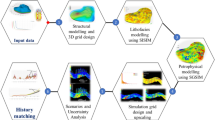Abstract
Stochastic modeling techniques have been widely applied to oil-gas reservoir lithofacies. Markov chain simulation, however, is still under development, mainly because of the difficulties in reasonably defining conditional probabilities for multi-dimensional Markov chains and determining transition probabilities for horizontal strike and dip directions. The aim of this work is to solve these problems. Firstly, the calculation formulae of conditional probabilities for multi-dimensional Markov chain models are proposed under the full independence and conditional independence assumptions. It is noted that multi-dimensional Markov models based on the conditional independence assumption are reasonable because these models avoid the small-class underestimation problem. Then, the methods for determining transition probabilities are given. The vertical transition probabilities are obtained by computing the transition frequencies from drilling data, while the horizontal transition probabilities are estimated by using well data and the elongation ratios according to Walther’s law. Finally, these models are used to simulate the reservoir lithofacies distribution of Tahe oilfield in China. The results show that the conditional independence method performs better than the full independence counterpart in maintaining the true percentage composition and reproducing lithofacies spatial features.
摘要
随机建模方法已经被广泛地应用于油气储层岩相的模拟中。然而,基于马尔科夫链的模拟技术 仍然处于发展和完善中。这主要是由于在合理定义多维马尔科夫链的条件概率和水平方向上的转移概 率时存在困难。本文着力解决这些问题。首先,基于完全独立假设和条件独立假设推导出了多维马尔 科夫链条件概率的计算公式,并指出因为基于条件独立假设的多维马尔科夫链解决了小类过度小估计 问题,所以更为合理。然后,给出了计算转移概率的方法:垂直方向上的转移概率可以通过统计井数 据中的转移频数获取,水平方向上的转移概率则基于井数据和延伸率运用Walther 定律估算得到。最 后,运用提出的模型对中国塔河油田储层岩相的分布进行随机模拟。结果表明:与完全独立假设相比, 基于条件独立假设的随机模拟结果更接近真实的岩相比例并能更好地重现岩相的空间特征。
Similar content being viewed by others
References
SALOMÃO M C, REMACRE A Z. The use of discrete Markov random fields in reservoir characterization [J]. Journal of Petroleum Science and Engineering, 2001, 32(2): 257–264.
LIANG Y, WANG Z, GUO J. Reservoir lithology stochastic simulation based on Markov random fields [J]. Journal of Central South University, 2014, 21(9): 3610–3616.
STREBELLE S. Conditional simulation of complex geological structures using multiple-point statistics [J]. Mathematical Geology, 2002, 34(1): 1–21.
KOLBJØRNSEN O, STIEN M, KJØNSBERG H, FJELLVOLL B, ABRAHAMSEN P. Using multiple grids in Markov mesh facies modeling [J]. Mathematical Geosciences, 2014, 46(2): 205–225.
CAO J H, YANG J C, WANG Y C, WANG D, SHI Y C. Extreme learning machine for reservoir parameter estimation in heterogeneous sandstone reservoir [J]. Mathematical Problems in Engineering, DOI: 10.1155/2015/287816.
CAO R, MA Y Z, GOMEZ E. Geostatistical applications in petroleum reservoir modelling [J]. Journal of the Southern African Institute of Mining and Metallurgy, 2014, 114(8): 625–631.
SOLEIMANI M, SHOKRI B J. 3D static reservoir modeling by geostatistical techniques used for reservoircharacterization and data integration [J]. Environmental Earth Sciences, 2015, 74(2): 1403–1414.
EIDSVIK J, MUKERJI T, SWITZER P. Estimation of geological attributes from a well log: An application of hidden markov chains [J]. Mathematical Geology, 2004, 36(3): 379–397.
LI Jun, XIONG Li, ZHANG Li, BIAN Guo, LIU Jian. Facies controlled stochastic modeling based on Markov chain models [J]. Progress in Geophysics, 2010, 25(1): 298–302. (in Chinese)
CARLE S F, FOGG G E. Transition probability-based indicator geostatistics [J]. Mathematical Geology, 1996, 28(4): 453–476.
NIKOOGOFTAR H, MEHRGINI B, BAHROUDI A, TOKHMECHI B. Optimization of the Markov chain for lithofacies modeling: An Iranian oil field [J]. Arabian Journal of Geosciences, 2015, 8(2): 799–808.
CAO G, KYRIAKIDIS P C, GOODCHILD M F. Combining spatial transition probabilities for stochastic simulation of categorical fields [J]. International Journal of Geographical Information Science, 2011, 25(11): 1773–1791.
HUANG X, WANG Z, GUO J. Prediction of categorical spatial data via Bayesian updating [J]. International Journal of Geographical Information Science, 2016, 30(7): 1426–1449.
VISTELIUS A B. On the question of the mechanism of formation of strata [J]. Doklady Akademii Nauk SSSR, 1949, 65(2): 191–194.
CARLE S F, FOGG G E. Modeling spatial variability with one and multidimensional continuous-lag Markov chains [J]. Mathematical Geology, 1997, 29(7): 891–918.
ELFEKI A, DEKKING M. A Markov chain model for subsurface characterization: theory and applications [J]. Mathematical Geology, 2001, 33(5): 569–589.
LI Jun, YANG Xiao, ZHANG Xiao, XIONG Li. Lithologic stochastic simulation based on the three-dimensional Markov chain model [J]. Acta Petrolei Sinica, 2012, 33(5): 846–853. (in Chinese)
LI W. Markov chain random fields for estimation of categorical variables [J]. Mathematical Geology, 2007, 39(3): 321–335.
LIU Zhen, HAO Tian, FANG Hui. Modeling of stochastic reservoir lithofacies with Markov chain model. Acta Petrolei Sinica, 2005, 26(5): 57–60. (in Chinese)
HUANG X, WANG Z, GUO J. Theoretical generalization of Markov chain random field from potential function perspective [J]. Journal of Central South University, 2016, 23(1): 189–200.
PAN H, LUO M, ZHANG Z, FAN Z. Lateral contrast and prediction of carboniferous reservoirs using logging data in Tahe oilfield, Xinjiang, China [J]. Journal of Earth Science, 2010, 21(4): 480–488.
YANG Kai, AI Di, GENG Jian. A new geostatistical inversion and reservoir modeling technique constrained by well-log, crosshole and surface seismic data [J]. Chinese Journal of Geophysics, 2012, 55(8): 2695–2704. (in Chinese)
Author information
Authors and Affiliations
Corresponding author
Additional information
Foundation item: Project(2016YFB0503601) supported by the National Key Research and Development Program of China; Project(41730105) supported by the National Natural Science Foundation of China
Rights and permissions
About this article
Cite this article
Wang, Zz., Huang, X. & Liang, Yr. Oil-gas reservoir lithofacies stochastic modeling based on one- to three-dimensional Markov chains. J. Cent. South Univ. 25, 1399–1408 (2018). https://doi.org/10.1007/s11771-018-3835-3
Received:
Accepted:
Published:
Issue Date:
DOI: https://doi.org/10.1007/s11771-018-3835-3
Key words
- independence assumption
- Markov chain
- reservoir lithofacies
- small-class underestimation
- transition probability




